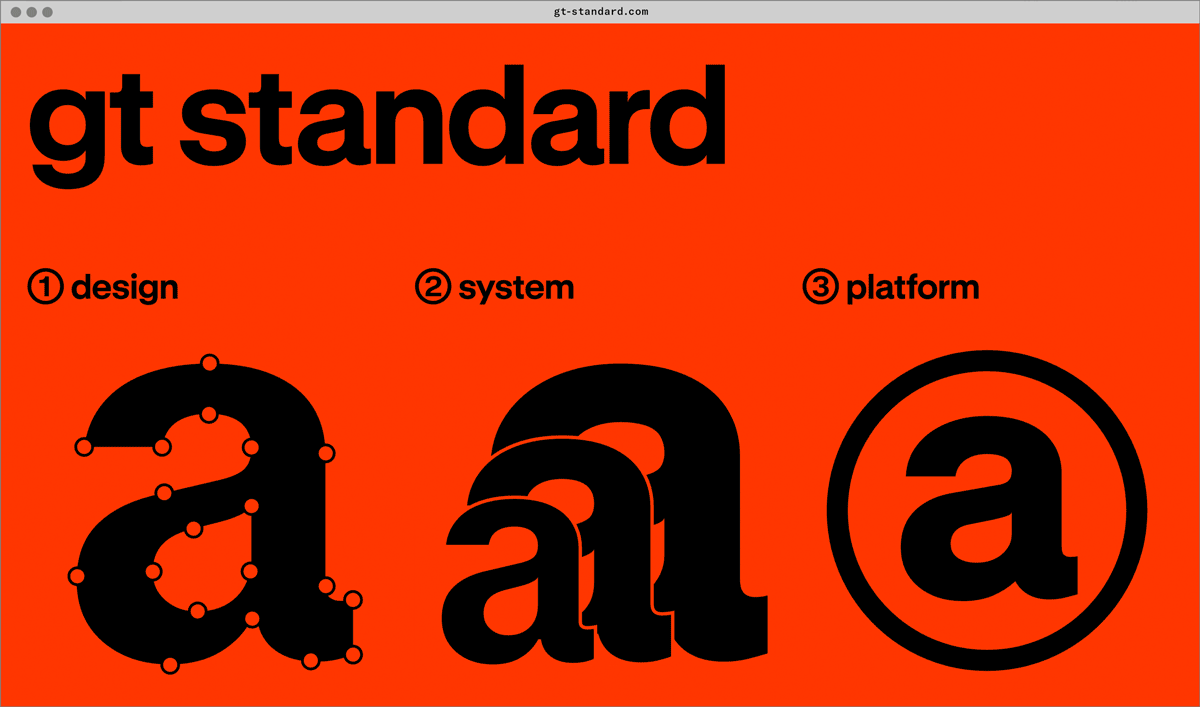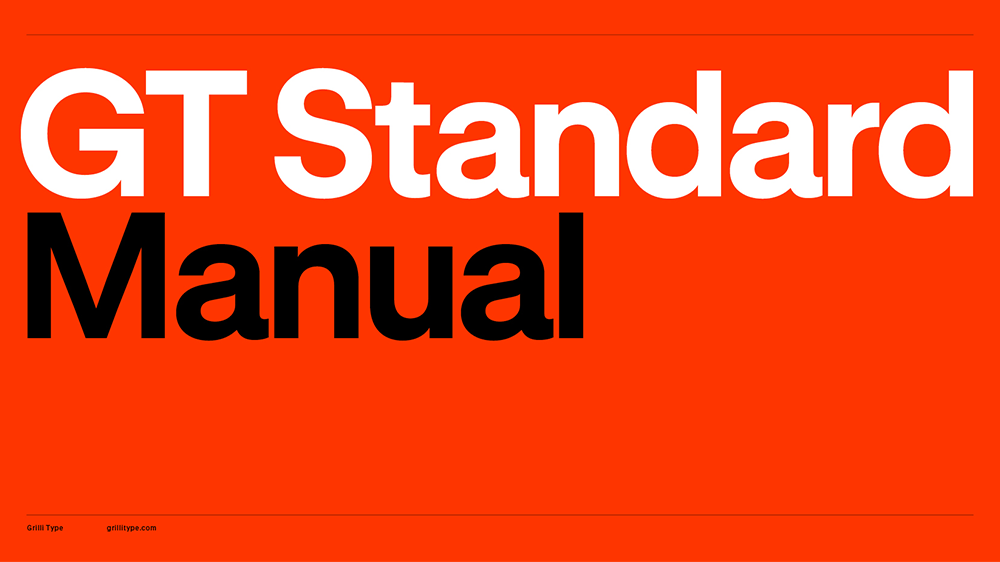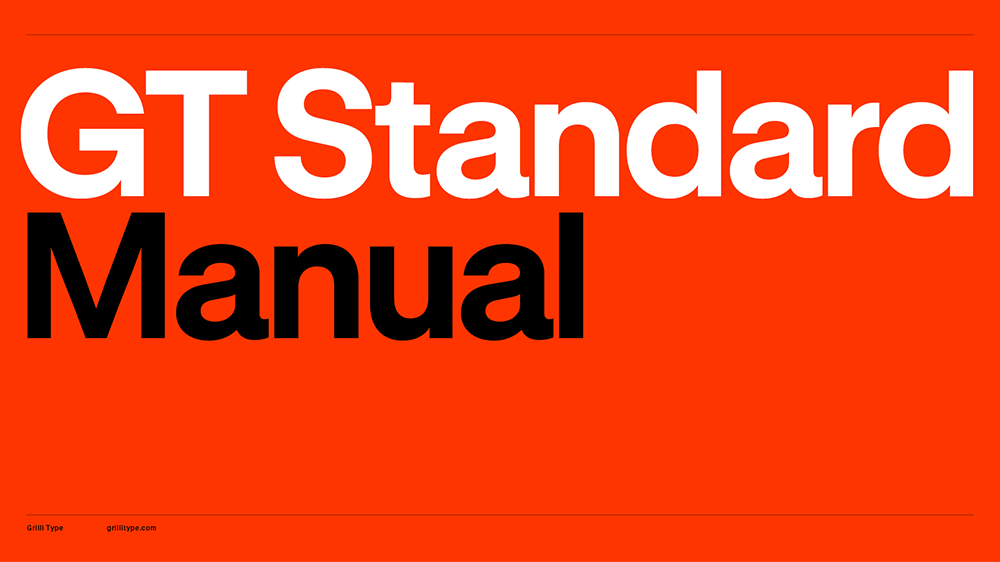GT Standard
Family overview
- Compressed
- S Light Oblique
- M Light Oblique
- L Light Oblique
- S Regular Oblique
- M Regular Oblique
- L Regular Oblique
- S Medium Oblique
- M Medium Oblique
- L Medium Oblique
- S Semibold Oblique
- M Semibold Oblique
- L Semibold Oblique
- S Bold Oblique
- M Bold Oblique
- L Bold Oblique
- S Heavy Oblique
- M Heavy Oblique
- L Heavy Oblique
- S Black Oblique
- M Black Oblique
- L Black Oblique
- Condensed
- S Light Oblique
- M Light Oblique
- L Light Oblique
- S Regular Oblique
- M Regular Oblique
- L Regular Oblique
- S Medium Oblique
- M Medium Oblique
- L Medium Oblique
- S Semibold Oblique
- M Semibold Oblique
- L Semibold Oblique
- S Bold Oblique
- M Bold Oblique
- L Bold Oblique
- S Heavy Oblique
- M Heavy Oblique
- L Heavy Oblique
- S Black Oblique
- M Black Oblique
- L Black Oblique
- Narrow
- S Light Oblique
- M Light Oblique
- L Light Oblique
- S Regular Oblique
- M Regular Oblique
- L Regular Oblique
- S Medium Oblique
- M Medium Oblique
- L Medium Oblique
- S Semibold Oblique
- M Semibold Oblique
- L Semibold Oblique
- S Bold Oblique
- M Bold Oblique
- L Bold Oblique
- S Heavy Oblique
- M Heavy Oblique
- L Heavy Oblique
- S Black Oblique
- M Black Oblique
- L Black Oblique
- Standard
- S Light Oblique
- M Light Oblique
- L Light Oblique
- S Regular Oblique
- M Regular Oblique
- L Regular Oblique
- S Medium Oblique
- M Medium Oblique
- L Medium Oblique
- S Semibold Oblique
- M Semibold Oblique
- L Semibold Oblique
- S Bold Oblique
- M Bold Oblique
- L Bold Oblique
- S Heavy Oblique
- M Heavy Oblique
- L Heavy Oblique
- S Black Oblique
- M Black Oblique
- L Black Oblique
- Extended
- S Light Oblique
- M Light Oblique
- L Light Oblique
- S Regular Oblique
- M Regular Oblique
- L Regular Oblique
- S Medium Oblique
- M Medium Oblique
- L Medium Oblique
- S Semibold Oblique
- M Semibold Oblique
- L Semibold Oblique
- S Bold Oblique
- M Bold Oblique
- L Bold Oblique
- S Heavy Oblique
- M Heavy Oblique
- L Heavy Oblique
- S Black Oblique
- M Black Oblique
- L Black Oblique
- Expanded
- Mono Compressed
- Light Oblique
- Regular Oblique
- Medium Oblique
- Semibold Oblique
- Bold Oblique
- Heavy Oblique
- Black Oblique
- Mono Condensed
- Light Oblique
- Regular Oblique
- Medium Oblique
- Semibold Oblique
- Bold Oblique
- Heavy Oblique
- Black Oblique
- Mono Narrow
- Light Oblique
- Regular Oblique
- Medium Oblique
- Semibold Oblique
- Bold Oblique
- Heavy Oblique
- Black Oblique
- Mono Standard
- Light Oblique
- Regular Oblique
- Medium Oblique
- Semibold Oblique
- Bold Oblique
- Heavy Oblique
- Black Oblique
- Mono Extended
- Light Oblique
- Regular Oblique
- Medium Oblique
- Semibold Oblique
- Bold Oblique
- Heavy Oblique
- Black Oblique
- Mono Expanded
Subfamilies
- Standard S LightIn 1928, the AESC became the American Standards Association (ASA). In 1966, the ASA was reorganized and became United States of America Standards Institute (USASI). The present name was adopted in 1969.
- Standard M LightIn contrast, a custom, convention, company product, corporate standard, and so forth that becomes generally accepted and dominant is often called a de facto standard.
- Standard L LightMicrosoft Word DOC. Due to the market dominance of Word, it is supported by all office applications that intend to compete with it, typically by reverse engineering the undocumented file format.
- Standard S Light ObliqueANSI accredits standards that are developed by representatives of other standards organizations, government agencies, consumer groups, companies, and others.
- Standard M Light ObliqueAccording to Adam Stanton, the first permanent secretary and head of staff in 1919, AESC started as an ambitious program and little else. Staff for the first year consisted of one executive, Clifford B. LePage, who was on loan from a founding member, ASME.
- Standard L Light ObliqueUSB for high speed serial interface in computers and for powering or charging low power external devices (like mobile phones, headphones, portable hard drives) usually using micro USB plug and socket.
- Standard S RegularTechnical barriers arise when different groups come together, each with a large user base, doing some well established thing that between them is mutually incompatible.
- Standard M RegularMIDI connection (using DIN connector or Phone connector), electrical and protocol standard for connecting musical instruments, synthesizers, drum machines, sequencers, and some audio equipment.
- Standard L RegularBecause of the great influence of the IBM PC on the personal computer market, competing products like the Rainbow 100 were eventually withdrawn.
- Standard S Regular ObliqueIn social sciences a voluntary standard that is also a de facto standard is a typical solution to a coordination problem. The choice of a de facto standard tends to be stable in situations in which all parties can realize mutual gains, but only by making mutually consistent decisions. In contrast, an enforced de jure standard is a solution to the prisoner's problem.
- Standard M Regular ObliqueThe existence of a published standard does not imply that it is always useful or correct. For example, if an item complies with a certain standard, there is not necessarily assurance that it is fit for any particular use.
- Standard L Regular ObliqueNot all technical standards are created equal. In the development of a technical standard, private standards adopt a non-consensus process in comparison to voluntary consensus standards.
- Standard S MediumThe American National Standards Institute is a private nonprofit organization that oversees the development of voluntary consensus standards for products, services, processes, systems, and personnel in the United States.
- Standard M MediumThese standards ensure that the characteristics and performance of products are consistent, that people use the same definitions and terms, and that products are tested the same way.
- Standard L MediumIn 1928, the AESC became the American Standards Association (ASA). In 1966, the ASA was reorganized and became United States of America Standards Institute (USASI). The present name was adopted in 1969.
- Standard S Medium ObliqueTechnical standards may exist as published documents available for purchase or private documents owned by an organization or corporation, used and circulated as the owner determines necessary or useful
- Standard M Medium ObliquePrivate standards are developed by private entities such as companies, non-governmental organizations or private sector multi-stakeholder initiatives, also referred to as multistakeholder governance.
- Standard L Medium ObliqueWhen a geographically defined community must solve a community-wide coordination problem, it can adopt an existing standard or produce a new one.
- Standard S SemiboldThe MP3 audio format started as an alternative to WAV for internet music distribution, then replaced it. It is now supported by the vast majority of music players, audio transport, audio storage, and non-commercial media.
- Standard M SemiboldTechnical standards are defined as voluntary consensus standards, which are standards developed or adopted by voluntary consensus standards bodies, domestic (national), regional and international.
- Standard L SemiboldIn social sciences, including economics, a standard is useful if it is a solution to a coordination problem: it emerges from situations in which all parties realize mutual gains, but only by making mutually consistent decisions.
- Standard S Semibold ObliquePCI Express electrical and mechanical interface, and interconnect protocol used in computers, servers, and industrial applications.
- Standard M Semibold ObliqueOther standards make things work together. For example, rail cars with a standard gauge can run on tracks that follow the same standard.
- Standard L Semibold ObliqueThe ANSI/APSP (Association of Pool & Spa Professionals) standards used for pools, spas, hot tubs, barriers, and suction entrapment avoidance.
- Standard S BoldMicrosoft has repeatedly internally changed the file specification between versions of Word to suit their own needs, while continuing to reuse the same file extension identifier for different versions.
- Standard M BoldStandards organizations often have more diverse input and usually develop voluntary standards: these might become mandatory if adopted by a government (i.e., through legislation), business contract, etc.
- Standard L Bold2.54 mm (0.1 inch) pin spacing on many electronic components, including DIP, SIL packages, header connectors, and many more. The standard spacing enable use of these devices in prototyping boards and standardized sockets.
- Standard S Bold ObliqueThe American National Standards Institute is a private nonprofit organization that oversees the development of voluntary consensus standards for products, services, processes, systems, and personnel in the United States.
- Standard M Bold ObliqueInternational standards is one way of overcoming technical barriers in inter-local or inter-regional commerce caused by differences among technical regulations and standards developed independently and separately by each local, local standards organisation, or local company.
- Standard L Bold ObliqueA technical standard includes definition of terms; classification of components; delineation of procedures; specification of dimensions, materials, performance, designs, or operations; measurement of quality and quantity in describing materials, processes, products, systems, services, or practices; test methods and sampling procedures; or descriptions of fit and measurements of size or strength.
- Standard S HeavyFor example, a physical property of a material is often affected by the precise method of testing: any reference to the property should therefore reference the test method used.
- Standard M HeavyTeX typesetting system, commonly used in creating scientific articles and reports for publication (in fact many journals require the publication to be fully written in TeX)
- Standard L HeavyPrivate standards are developed by private entities such as companies, non-governmental organizations or private sector multi-stakeholder initiatives, also referred to as multistakeholder governance.
- Standard S Heavy ObliquePCI Express electrical and mechanical interface, and interconnect protocol used in computers, servers, and industrial applications.
- Standard M Heavy Oblique2.54 mm (0.1 inch) pin spacing on many electronic components, including DIP, SIL packages, header connectors, and many more. The standard spacing enable use of these devices in prototyping boards and standardized sockets.
- Standard L Heavy ObliqueThese standards ensure that the characteristics and performance of products are consistent, that people use the same definitions and terms, and that products are tested the same way.
- Standard S BlackFor example, there may be a specification for a turbine blade for a jet engine that defines the exact material and performance requirements.
- Standard M BlackTechnical barriers arise when different groups come together, each with a large user base, doing some well established thing that between them is mutually incompatible.
- Standard L BlackCommunication protocols such as Morse code and USB are standards that allow different machines and people to communicate.
- Standard S Black ObliqueIn social sciences a voluntary standard that is also a de facto standard is a typical solution to a coordination problem. The choice of a de facto standard tends to be stable in situations in which all parties can realize mutual gains, but only by making mutually consistent decisions. In contrast, an enforced de jure standard is a solution to the prisoner's problem.
- Standard M Black ObliqueUSB for high speed serial interface in computers and for powering or charging low power external devices (like mobile phones, headphones, portable hard drives) usually using micro USB plug and socket.
- Standard L Black ObliqueDMX512 (commonly just DMX) with XLR connector to control and sometimes power stage and venue lights, effects, smoke machines, laser projectors, and pyrotechnics.
- Settings
Typeface information
GT Standard is a contemporary response to the modernist pursuit of standardization. It’s rooted in the principles of Swiss Style and expands on this legacy to meet the needs of today’s visual landscape. The typeface is systematic yet expressive, built for clarity, adaptability, and precision across every scale and medium.
Typeface features
OpenType features enable smart typography. You can use these features in most Desktop applications, on the web, and in your mobile apps. Each typeface contains different features. Below are the most important features included in GT Standard’s fonts:
- SS01
- Alternate a
Regards
- SS02
- Alternate g
Engaging
- SS03
- Alternate y
Energy
- SS04
- Alternate Q
Quality
- SS06
- Rectangular Dots
Minimalism
- SS07
- Account Spoofing
Informal
Typeface Minisite


- Visit the GT Standard minisite to discover more about the typeface family’s history and design concept.

